Before the year 2023 comes to an end, let me devote this space to the 50 th anniversary of
the start of what became an agricultural revolution in Suffolk County: the creation here of a
world-class region for the production of wine.
As the Long Island Wine Council declares on its website: “Alex and Louisa Hargrave planted the first Long Island vineyard in 1973, in Cutchogue. Soon after, pioneering investors, grape-growers, and winemakers followed suit.” Now, the “Long Island wine region is one of the most exciting rising stars of the
winemaking world.”
Under “Who We Are,” it notes: “Long Island boasts 57 distinct wine producers, who are
divided between the North Fork, South Fork, and western Suffolk County.”
In western and central Suffolk, vineyards now include Del Vino Vineyards in Northport,
Whisper Vineyards in St. James, Harmony Vineyards in Head of the Harbor and Loughlin
Vineyard in Sayville. On the South Fork, the wineries include Wolffer Estate in Sapaponack,
Channing Daughters in Bridgehampton and Duck Walk Vineyards in Water Mill. On the North
Fork, there are vineyard after vineyard along Sound Avenue and, too, on Route 25. Also, Shelter
Island has gotten its first vineyard.
As noted in an article last month in The Shelter Island Reporter, Joel Assouline has “taken inspiration from France’s Loire Valley, which has a similar latitude and topography to this region.”
A half-century ago, a climatic link between Suffolk County and the great wine-producing
regions of Europe was hardly known.
“I was 25 and Alex was 27,” writes Louisa Hargrave in her book, The Vineyard. “With
no farm experience and little life experience, we really didn’t think the vines would need much
attention. Before we bought the farm in Cutchogue, neither one of us had grown as much as a
vegetable garden…The idea of the vineyard at that point was still a fantasy whose only tangible
basis in reality lay in the 10,000 rooted, grafted vines we had bought.”
But the couple shared a love for fine wine.
And, as she relates, John Tomkins, a pomologist for Cornell Cooperative Extension in
Ithaca, told them: “There’s this guy on Long Island who has been growing table grapes.”
That was John Wickham, who worked some of the oldest continually cultivated land in
what is now the United States—on a 287-acre farm in Cutchogue that goes back to 1661.
Wickham told the couple of he had been “called crazy” for moving away from potatoes to grow
peaches and cherries and other fruit on Long Island.
“He took us to bodies of water and explained how they moderated the climate,” she
explains. Thus they figured they could grow cabernet sauvignon and pinot noir and merlot and
chardonnay here, the grapes from which the great wines of Bordeaux and Burgandy were made.
And the Hargraves were correct.
John Wickham, who died in 1994 at 85, was long a farmer and also long vice chairman of
the Suffolk County Planning Commission chairman of the Southold Town Planning Board, too.
He had a deep commitment to preserving Suffolk County as a leading agricultural area in New
York State. Running the farm now, with the same commitment, are Thomas Wickham, a former
Southold Town supervisor and councilman, and his family.
An article that ran 20 years ago in Long Island Business News, on the 30 th anniversary of
this area becoming a wine-growing region, asserted: “There is a general feeling that the wine
industry has ‘saved’ the North Fork’s open spaces and rural nature.”
Importantly, most of the land where now there are vineyards had been used to grow
potatoes. and with the once mighty Long Island potato facing stiff competition, the wine industry
utilizing expensive Long Island land has made more financial sense.
Moreover, the creation of the Suffolk County Farmland Preservation Program, begun in
1974, and the Community Preservation Fund in the five East End towns, and other town, county,
state and private initiatives to save farms has been instrumental in the proliferation of vineyards
here.
The wine industry, further, has also been a great boon to Long Island tourism.
The headline of a 1999 article in Business Week was “A Wine Region That’s Aging
Beautifully.” It noted how the vision of the Hargraves “has come to pass” and winemakers that
succeeded the Hargraves—they sold their winery that year—“seems to have a story. Mostly,
they’re about dreams that have come true.”
The Express Magazine, published by the Express New Group, related this summer, in an
extensive six-page article by Michelle Trauring titled “50 Years of Long Island Wine,” that “the
moment” the Hargraves “planted their first grapes, they founded an entire wine region.”
The piece (it’s online) quoted Roman Roth, winemaker and partner at Wolffer Estate, saying: “Long Island is unique. The elegant wines that Long Island makes, the fresh wine, the
wines with less alcohol, the dry roses, these are all things that have an impact on winemaking in
America and certainly can complete with the best wines in the world. That’s a huge statement, a
huge thing to celebrate.”

